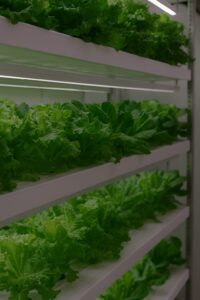Introduction
A brilliantly simple and accurate way to describe a farmer’s job is this: reduce stress on your plants by maintaining a balanced, consistent, and homogenous environment. That’s it. Every decision in agriculture—vertical or traditional—should support this goal. Because at its core, vertical farming is still farming.
Initially hailed as a revolutionary approach to food production, vertical farming hit a wall—hard. Companies that once captured headlines fell short due to flawed strategies: funding models focused on hype instead of long-term profitability, misaligned leadership, and a race to scale without mastering the basics. This led to unsustainable operations and missed opportunities to truly solve urban food security and resource efficiency.
Yet, despite its early stumbles, vertical farming is far from dead. When grounded in unit economics, powered by smart energy strategies, led by agronomic expertise, and aimed at diversified, high-value crops, it becomes a compelling solution for the future of food. This article explores how to reposition vertical farming from failed hype to long-term profitability and sustainability.
Key Challenges in Vertical Farming
Vertical farming and controlled environment agriculture (CEA) face steep hurdles:
- Energy Costs: Maintaining climate-controlled environments is expensive and has made many ventures unprofitable.
- Crop Saturation: Oversupply of low-margin crops like microgreens has led to diminishing returns.
- Inexperienced Leadership: Many farms lack agronomic leadership, leading to inefficiencies and crop failure.
- Misaligned Funding Models: Traditional VC approaches prioritize speed over sustainability, which doesn’t suit agriculture.
- Weak Pathogen Control: Disease management is often neglected, resulting in significant crop losses.
Addressing these challenges is the first step toward unlocking the true potential of vertical farming.
Pathways to Profitability
1. Energy Efficiency and Independence
Self-generated energy is non-negotiable. The vertical farms that failed often did so because they underestimated power needs. Solutions include:
- On-site renewable energy sources.
- Energy-efficient LEDs with machine learning-driven dimming based on plant cycles.
- Smart climate control systems powered by the farm’s own grid.
Reducing energy costs directly impacts profitability and investor appeal.
2. Diversified Cultivars and Medicinal Plants
Relying solely on lettuce and basil is a dead end. Growth lies in:
- High-value medicinal plants for health and wellness markets.
- Specialty and niche crops tailored to emerging consumer trends.
- Diversifying SKUs to adapt to shifting demand and reduce market volatility.
This crop diversity also supports better food security and ecosystem health.
3. Agronomy-Led Leadership
You can’t automate good judgment. Agronomists and experienced growers should be leading vertical farm operations. Their expertise:
- Maximizes yield through optimized nutrient and pest strategies.
- Aligns crop planning with market needs.
- Improves biosecurity protocols to reduce disease risk.
Smart leadership rooted in plant science is the backbone of a resilient farm.
4. Milestone-Based Funding with Unit Economics
Fast-scaling VC models don’t align with agricultural timelines. Instead, farms should:
- Focus on measurable milestones tied to cost reduction, yield improvement, and market acquisition.
- Prioritize COGS optimization over headline growth.
- Invest only in technologies that directly improve plant health or operational efficiency.
This funding strategy attracts more sustainable investors and reduces burn rates.
5. Pathogen Mitigation and Sanitation
CEA environments are vulnerable to pathogens due to close crop proximity. Mitigation strategies must include:
- Integrated Pest Management (IPM).
- Advanced air and water filtration systems.
- Strict sterilization protocols for tools and surfaces.
Strong sanitation not only improves yields—it builds market trust.
6. Strategic Crop and Market Diversity
Crop variety alone isn’t enough. Farms need to diversify their market approach as well:
- Serve multiple consumer segments (local, retail, pharma).
- Reduce reliance on a single market by developing both B2B and DTC channels.
- Use crop diversity as a hedge against trade disruptions, supply chain breakdowns, or consumer trend shifts.
This strategic agility gives vertical farms a major edge over traditional agriculture.
Conclusion
Vertical farming’s early failures weren’t due to a broken concept—they were due to broken execution. By refining five critical areas—energy independence, crop diversity, agronomic leadership, funding discipline, and pathogen control—vertical farms can become not just viable, but vital.
For investors, agribusiness professionals, and entrepreneurs, vertical farming represents an evolving frontier of opportunity. The playbook is no longer “scale fast or die.” It’s scale smart, grow resilient, and stay rooted in the fundamentals of farming.



